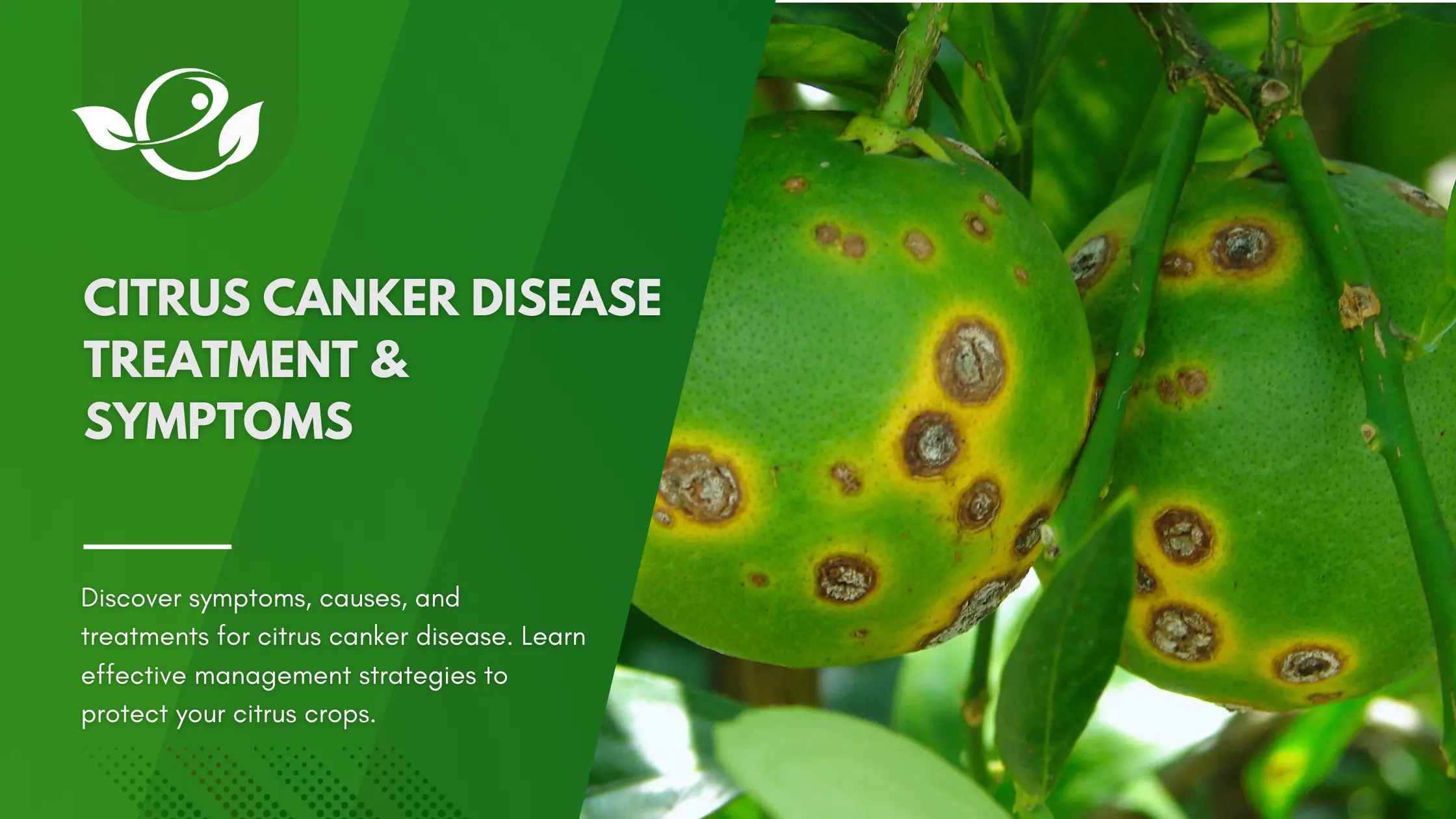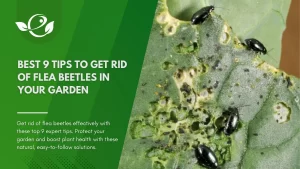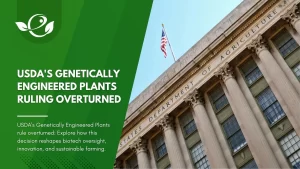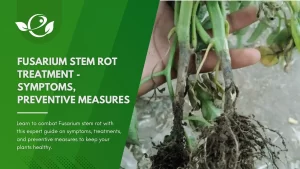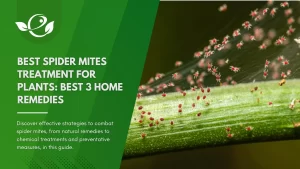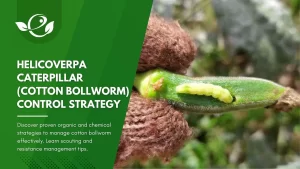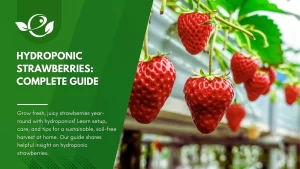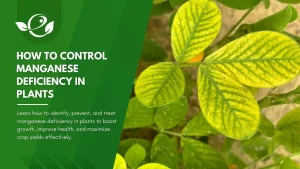Table of Contents
Citrus canker is a highly contagious bacterial disease that affects citrus trees, causing significant economic losses worldwide. This disease, caused by the bacterium Xanthomonas citri subsp. citri, manifests as lesions on leaves, stems, and fruits, leading to reduced fruit quality and yield. Understanding citrus canker is crucial for growers to manage and prevent its spread effectively.
This guide aims to provide a detailed and comprehensive understanding of citrus canker disease, including its symptoms, causes, diagnosis, and effective treatment methods. By offering in-depth insights and practical recommendations, this article seeks to empower citrus growers and industry stakeholders with the knowledge necessary to combat citrus canker effectively. Whether you are a seasoned citrus grower or a newcomer to the industry, this guide will equip you with the tools and information needed to protect your orchards and ensure a sustainable and productive future.
In the sections that follow, we will delve into the specifics of citrus canker, exploring the disease in detail from its early symptoms to advanced stages, examining the environmental factors that facilitate its spread, and discussing various management strategies. By understanding the intricacies of citrus canker, we can collectively work towards mitigating its impact and safeguarding the citrus industry for generations to come.
What caused it?
Citrus canker is a serious and highly contagious disease of commercial varieties of citrus and relatives. It is caused by the bacteria Xanthomonas citri, which can survive for periods of over 10 months in old lesions on fruits, leaves, and stems. It enters the plant’s tissues through wounds or natural pores in the leaf surface and grows there systemically. The craters that form on leaves and other tissues contain bacteria, that are released when wet and spread by rain splash or overhead irrigation systems over short distances.
Conditions that favor the disease are high humidity, hot (20 to 30 °C) and rainy weather conditions, ideally with strong winds. Citrus psyllids, leaf miners, birds, as well as infected tools and equipment can also transmit the bacteria between trees or groves. Finally, the movement of infected plants or plant parts such as nursery trees or propagation material is also a problem.
Symptoms
- Trees can be affected at all stages of their development and symptoms may appear on leaves, fruits or twigs. Tiny, slightly raised and spongy lesions develop first on both surfaces of newly-infected leaves.
- As they mature, these spots develop into rust-brown wart-like craters that are surrounded by a distinctive bright yellow halo.
- They eventually erupt, releasing their content, and forming a typical lesion with a light brown or gray center and oily, water-soaked brownish margin.
- Occasionally, the center of old cankers fall out, leaving behind a shot-hole effect. Similar symptoms can appear on fruits and twigs, where the cankers can reach a sizable dimension.
- The center of the lesion becomes characteristically raised, scabby or corky. Defoliation and premature fruit drop ensue and twigs may be killed by girdling of vascular tissues. Fruits that reach maturity are not marketable.
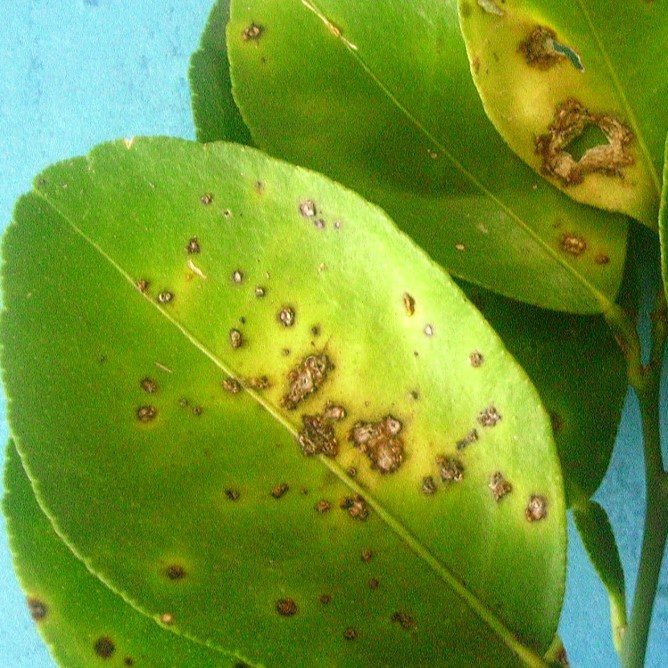
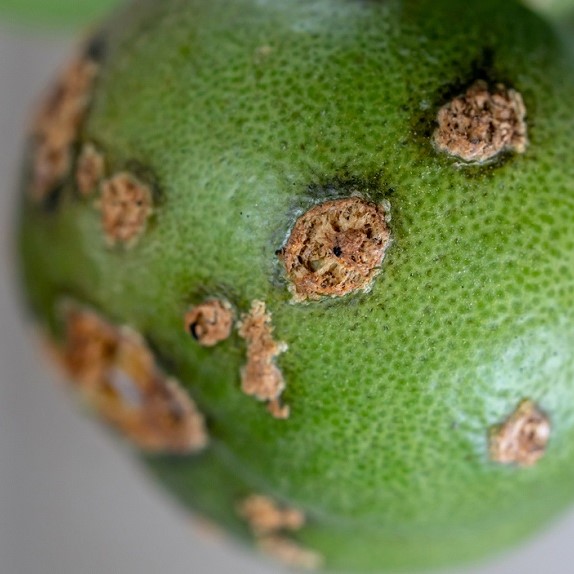
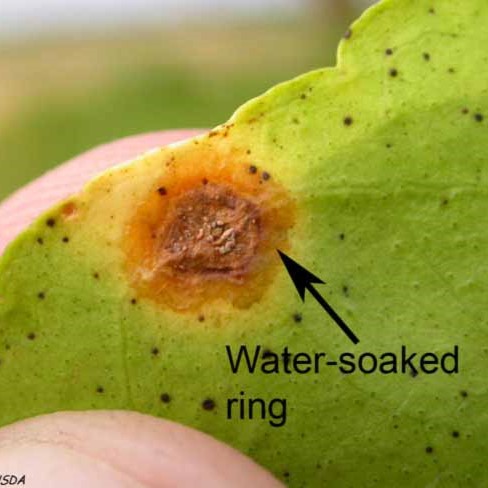
Early Symptoms
- Appearance of Lesions on Leaves
- The initial signs of citrus canker appear as small, raised lesions on the leaves. These lesions are typically round, water-soaked, and surrounded by a yellow halo. Over time, the lesions become more pronounced, developing a corky, scabby texture.
- Yellow Halo Around Lesions
- The yellow halo is a key diagnostic feature of citrus canker. It distinguishes citrus canker from other similar diseases. The halo results from the plant’s response to the bacterial infection, creating a zone of dead cells around the lesion.
B. Advanced Symptoms
- Lesions on Fruits and Stems
- As the disease progresses, similar lesions appear on fruits and stems. These lesions can cause significant damage, leading to fruit drop and reduced marketability. On fruits, the lesions are typically sunken and can lead to premature fruit drop or blemished fruit that is unmarketable.
- Leaf and Fruit Drop
- Infected leaves and fruits often drop prematurely, leading to severe yield losses. This can significantly impact the economic viability of citrus orchards, especially if the disease is widespread.
- Twig Dieback
- In advanced stages, the disease can cause twig dieback, further reducing the tree’s productivity. This symptom indicates a severe infection that can compromise the overall health and vigor of the tree.
C. Visual Identification
- Detailed Description of Lesions
- Lesions caused by citrus canker are usually raised, corky, and surrounded by an oily, water-soaked margin. They may appear scabby and can be felt as rough patches on the plant surface. These characteristics make citrus canker lesions distinct from those caused by other diseases.
- Comparison with Other Citrus Diseases
- It’s important to distinguish citrus canker from other citrus diseases such as greasy spot, melanose, and citrus scab. Greasy spot, for instance, causes yellowish-brown, greasy lesions without the raised, corky texture. Melanose leads to small, black lesions primarily on young leaves and fruit, while citrus scab causes rough, corky lesions primarily on young leaves and fruits.
Diagnosis of Citrus Canker
Accurate diagnosis is crucial for managing citrus canker effectively.
A. Field Inspection
- Signs and Symptoms to Look For
- During field inspections, look for the characteristic lesions on leaves, fruits, and stems. Early detection through regular monitoring is essential. Inspecting trees regularly, especially after rainstorms or periods of high humidity, can help in early detection and management.
B. Laboratory Testing
- PCR (Polymerase Chain Reaction) Tests
- PCR tests are highly accurate in detecting the presence of Xanthomonas citri subsp. citri. These tests can confirm the disease even in asymptomatic stages by amplifying the DNA of the bacterium, making it detectable even in small quantities.
- Bacterial Isolation and Identification
- Bacterial isolation involves culturing samples from infected plants in a laboratory to identify the bacterium. This method involves growing the bacteria on selective media and identifying it based on its morphological and biochemical characteristics.
Preventive Measures
- Check for quarantine regulations in the area.
- Chose citrus varieties that are more resistant to the disease.
- Be sure to buy healthy plant material, if possible from certified sources.
- Monitor the trees for signs of the disease.
- Prune away the part of the trees that are infected during the dry season.
- Sterilize tools and equipment between uses to prevent the spread of the disease.Do not work in the field when foliage is wet.
- Clean boot, clothes thoroughly when working between different orchards.
- Destroy severely infected trees to prevent infecting healthy trees nearby.
- Remove fallen leaves, fruits, and branches from the ground and destroy them.Use windbreaks between fields to avoid propagation.
Citrus canker disease treatment
A. Cultural Practices
- Pruning and Removing Infected Parts
- Regular pruning to remove and destroy infected plant parts can help reduce the bacterial load in an orchard. Pruning should be done during dry conditions to minimize the risk of spreading the bacteria.
- Proper Irrigation Methods
- Avoid overhead irrigation, which can splash water and bacteria onto healthy plants. Drip irrigation is a better alternative as it reduces leaf wetness and minimizes the risk of spreading the disease.
B. Chemical Control
Always consider an integrated approach with preventive measures together with biological treatments if available. Unfortunately, there is no effective control on citrus canker once it has been detected. Preventive measures such as the clearing and destruction of fallen tree material are essential to minimize the effect of the disease. The control of citrus psyllids can also be a way to limit the damage. Copper-based fungicides or bactericides can provide a barrier against infection, but they will not treat an existing infection.
- Use of Copper-Based Bactericides
- Copper-based bactericides can help reduce bacterial populations on the surface of plants. However, their effectiveness depends on timely and repeated applications. Overuse of copper can lead to resistance and environmental issues, so it should be used judiciously.
- Application Timing and Frequency
- The timing of bactericide applications is critical. They should be applied during periods of active growth and before rainy seasons. Regular applications during the growing season can help protect new growth from infection.
C. Biological Control
Unfortunately, no effective biological control methods are available at this time.
- Beneficial Microorganisms
- Research is ongoing into the use of beneficial microorganisms to control citrus canker. These microorganisms can inhibit the growth of Xanthomonas citri subsp. citri by competing for resources or producing antibacterial substances. Examples include specific strains of Bacillus and Pseudomonas that show promise in laboratory and field trials.
- Research and Advancements in Biocontrol
- Advances in biocontrol offer promising alternatives to chemical treatments. Continued research into the interactions between beneficial microbes and pathogens could lead to the development of more effective biocontrol strategies. Integrated pest management (IPM) programs incorporating biocontrol agents are being developed and tested in various citrus-growing regions.
D. Resistant Varieties
- Breeding and Genetic Resistance
- Developing and planting citrus varieties that are resistant to citrus canker is a long-term strategy for managing the disease. Breeding programs aim to combine desirable fruit qualities with resistance to citrus canker through traditional breeding techniques and modern genetic engineering approaches.
Final Thoughts
It is essential for citrus growers to adopt and adhere to best practices for managing citrus canker. Regular training and education on disease identification, quarantine protocols, and integrated pest management can empower growers to take proactive measures. Implementing these practices consistently helps reduce the spread of the disease and maintain healthy orchards.
Citrus canker is a formidable adversary for citrus growers, but with knowledge, vigilance, and collaboration, it can be managed effectively. This comprehensive guide provides the essential information needed to identify, diagnose, and treat citrus canker. By implementing the strategies outlined here and staying informed about ongoing research, the citrus industry can protect its crops, safeguard its economic viability, and contribute to a sustainable future for citrus production worldwide. Together, we can ensure that citrus orchards remain healthy, productive, and resilient against the threats posed by citrus canker.
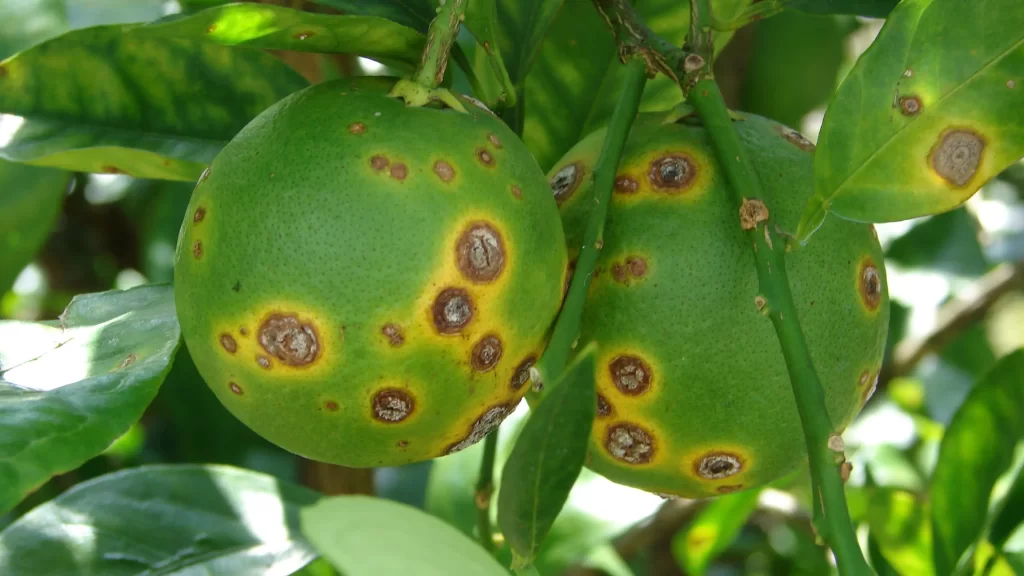
FAQ
What is the biological control of citrus cankers?
Unfortunately, no effective biological control methods are available at this time.
What is the best spray for citrus cankers?
The best sprays for managing citrus canker typically involve copper-based bactericides, which are effective in reducing the bacterial population on the surface of citrus plants. These sprays include:
Copper Hydroxide: Commonly used in various formulations and known for its effectiveness in managing bacterial infections.
Copper Oxychloride: Another effective copper-based compound often used in citrus canker management.
Copper Sulfate: Widely used in combination with lime (Bordeaux mixture) to control bacterial and fungal diseases.
These sprays need to be applied regularly, especially during periods of active growth and before rainy seasons, to ensure effective control.
What plants are affected by citrus canker?
Citrus canker primarily affects citrus plants, including:
Sweet Orange (Citrus sinensis)
Lemon (Citrus limon)
Lime (Citrus aurantiifolia and Citrus latifolia)
Grapefruit (Citrus paradisi)
Tangerine/Mandarin (Citrus reticulata)
Is citrus canker a communicable disease?
Yes, citrus canker is a communicable disease. It spreads through various means, including:
Wind-Driven Rain: Wind and rain can carry the bacteria over long distances and facilitate its entry into plants through natural openings or wounds.
Infected Tools and Equipment: Contaminated pruning tools, equipment, and even workers’ hands and clothing can spread the bacteria from one plant to another.
Movement of Infected Plant Material: Transporting infected plants, fruits, or plant parts can introduce the disease to new areas.
Is canker a fungal disease?
No, citrus canker is not a fungal disease. It is caused by the bacterium Xanthomonas citri subsp. citri. This bacterial pathogen infects citrus plants, causing characteristic lesions on leaves, stems, and fruits. It is important to differentiate citrus canker from other citrus diseases caused by fungi, such as citrus scab and melano
What is the scientific name for citrus cankers?
The scientific name for the bacterium that causes citrus canker is Xanthomonas citri subsp. citri. This pathogen is responsible for the characteristic symptoms of citrus canker, including raised, corky lesions on leaves, stems, and fruits, often surrounded by a yellow halo.
